
Jeroboam I was, according to the Hebrew Bible, the first king of the northern Kingdom of Israel following a revolt of the ten tribes against Rehoboam that put an end to the United Monarchy.
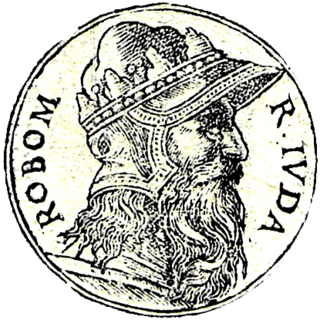
Rehoboam was, according to the Hebrew Bible, the first monarch of the Kingdom of Judah after the split of the united Kingdom of Israel. He was a son of and the successor to Solomon and a grandson of David. In the account of I Kings and II Chronicles, Rehoboam saw his rule limited to only the Kingdom of Judah in the south following a rebellion by the ten northern tribes of Israel in 932/931 BCE, which led to the formation of the independent Kingdom of Israel under the rule of Jeroboam in the north.
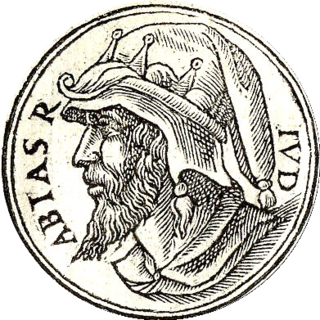
Abijam was, according to the Hebrew Bible, the fourth king of the House of David and the second of the Kingdom of Judah. He was the son of Rehoboam and the grandson of Solomon. The Books of Chronicles refer to him as Abijah.

The Codex Bezae Cantabrigiensis, designated by siglum Dea or 05, δ 5, is a codex of the New Testament dating from the 5th century written in an uncial hand on vellum. It contains, in both Greek and Latin, most of the four Gospels and Acts, with a small fragment of 3 John.
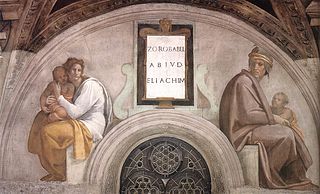
Matthew 1:13 is the thirteenth verse of Matthew 1 of the Gospel of Matthew in the New Testament. The verse is part of the section where the genealogy of Joseph, the father of Jesus, is listed. This verse covers the section somewhat after the Babylonian Captivity six generations before Jesus.
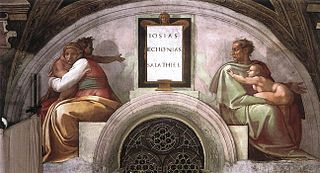
Matthew 1:12 is the twelfth verse of the first chapter of the Gospel of Matthew in the New Testament. The verse is part of the section where the genealogy of Joseph, the betrothed of Mary, the mother of Jesus Christ, is listed.

Matthew 1:11 is the eleventh verse of the first chapter of the Gospel of Matthew in the New Testament. The verse is part of the section where the genealogy of Joseph, the father of Jesus, is listed. It is the last verse of the middle third of the listing.
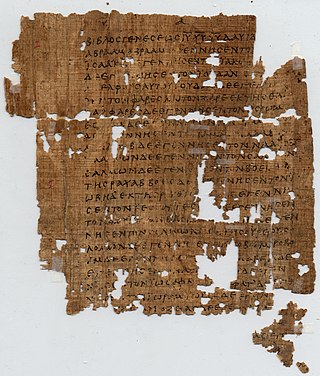
Matthew 1 is the first chapter of the Gospel of Matthew in the New Testament. It contains two distinct sections. The first lists the genealogy of Jesus from Abraham to his legal father Joseph, husband of Mary, his mother. The second part, beginning at verse 18, provides an account of the virgin birth of Jesus Christ.

Matthew 1:8 is the eighth verse of the first chapter of the Gospel of Matthew in the New Testament. The verse is part of the section where the genealogy of Joseph, the legal father of Jesus, is listed.

The Syriac Sinaiticus or Codex Sinaiticus Syriacus (syrs), known also as the Sinaitic Palimpsest, of Saint Catherine's Monastery, or Old Syriac Gospels is a late-4th- or early-5th-century manuscript of 179 folios, containing a nearly complete translation of the four canonical Gospels of the New Testament into Syriac, which have been overwritten by a vita (biography) of female saints and martyrs with a date corresponding to AD 697. This palimpsest is the oldest copy of the Gospels in Syriac, one of two surviving manuscripts that are conventionally dated to before the Peshitta, the standard Syriac translation.
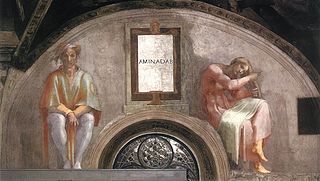
Matthew 1:4 is the fourth verse of the first chapter in the Gospel of Matthew in the New Testament. The verse is part of the section where the genealogy of Joseph, the legal father of Jesus, is listed.

Matthew 1:3 is the third verse of the first chapter in the Gospel of Matthew in the New Testament. The verse is part of the section where the genealogy of Joseph, the legal father of Jesus, is listed.

Matthew 1:2 is the second verse of the first chapter in the Gospel of Matthew in the New Testament. The verse is the first part of the section where the genealogy of Joseph, the legal father of Jesus, is listed.

Matthew 1:14 is the fourteenth verse of the first chapter of the Gospel of Matthew in the New Testament. The verse is part of the section where the genealogy of Joseph, the father of Jesus, is listed.

Matthew 1:15 is the fifteenth verse of the first chapter of the Gospel of Matthew in the New Testament. The verse is part of the section where the genealogy of Joseph, the father of Jesus, is listed.
Textual variants in the New Testament manuscripts arise when a copyist makes deliberate or inadvertent alterations to the text that is being reproduced. Textual criticism of the New Testament has included study of its textual variants.

Textual variants in the Gospel of Matthew are the subject of the study called textual criticism of the New Testament. Textual variants in manuscripts arise when a copyist makes deliberate or inadvertent alterations to a text that is being reproduced. An abbreviated list of textual variants in this particular book is given in this article below.
Textual variants in the Gospel of Mark are the subject of the study called textual criticism of the New Testament. Textual variants in manuscripts arise when a copyist makes deliberate or inadvertent alterations to a text that is being reproduced. An abbreviated list of textual variants in this particular book is given in this article below.
Textual variants in the Gospel of Luke are the subject of the study called textual criticism of the New Testament. Textual variants in manuscripts arise when a copyist makes deliberate or inadvertent alterations to a text that is being reproduced. An abbreviated list of textual variants in this particular book is given in this article below.
Textual variants in the Acts of the Apostles are the subject of the study called textual criticism of the New Testament. Textual variants in manuscripts arise when a copyist makes deliberate or inadvertent alterations to a text that is being reproduced. An abbreviated list of textual variants in this particular book is given in this article below.
















